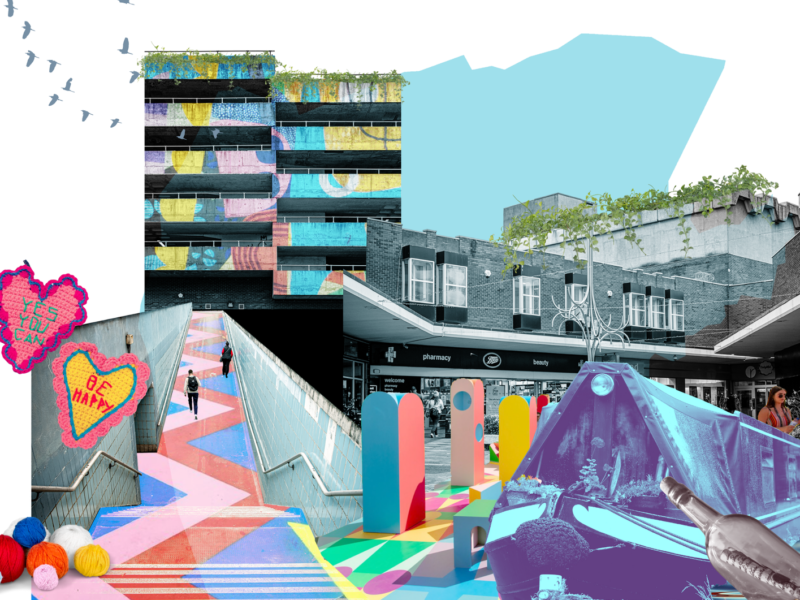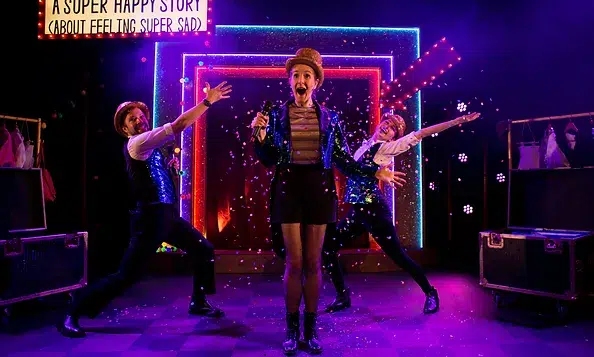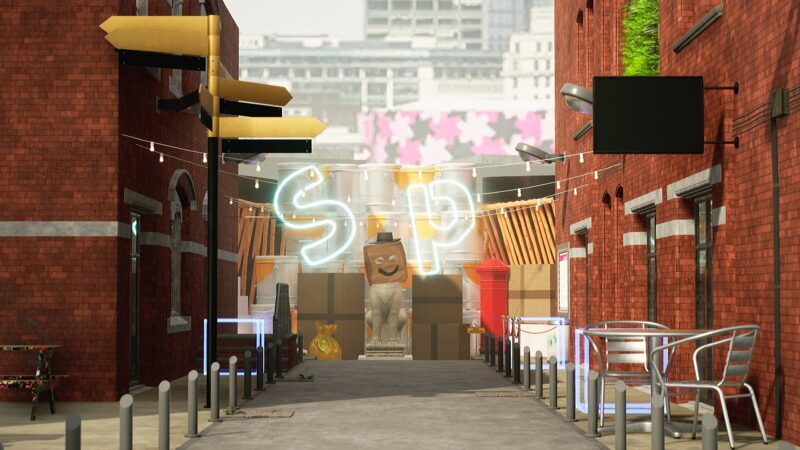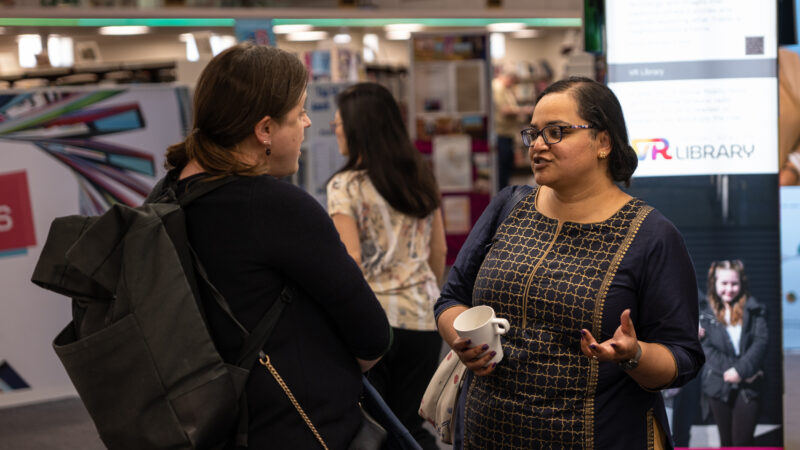Conversations and advice
In our latest podcasts, we are looking at the way artists and organisations can use digital when working with communities.
The appetite for working with communities, rather than for them is becoming ever more important. Let’s Create, ACE’s 10-year strategy, prioritises inclusivity and relevancy as a core principle, with the aim of delivering greater access, fairness and opportunity for everyone.
In these ‘cup of tea conversations’ we speak to artists and organisations whose work has community at heart and discuss what makes their approach successful, how they use digital, and how the work is evolving. Each episode lasts around 20 minutes and takes the form of a conversation over a lovely cuppa.
Below is the transcript for the second of these conversations with Sajida Carr from Creative Black Country.

Sajida Carr, Creative Black Country
Sajida Carr is Director of Operations and Development at Creative Black Country (CBC). Sajida shares tips on how CBC use digital and analogue as a two-pronged approach, the role of the enabler and facilitator in community lead projects and how their local community advisors keep them connected to the local area.
Speakers
Sajida Carr (Creative Black Country), Rob Lindsay (Head of Programmes, The Space), Clare Freeman (Podcast Producer)
Clare Freeman, podcast producer 0:04
Hi, Claire here. Welcome to The Space Arts podcast. Great to have you with us, this time over a steaming hot drink, we sit back and listen in to another fascinating conversation all around the topic of community collaboration. You can, of course, watch this recording in full as part of our webinar series. More info about how to do that in our episode description (Watch on YouTube, starting at 50:13). But first, I’ll make the introductions. Sajida Carr is one of the directors of Creative Black Country. Her and her team act as a catalyst, a broker, an enabler, and a facilitator in developing a programme that reflects the makeup of communities living within their fabulous corner of the West Midlands. She shares tips on how they use both digital and analogue as a two-pronged approach. her view of the role of the enabler, and facilitating community-led projects and why their weekly meeting with creative advisors helps keep them stay connected to the local area. First up, Sajida explained to my Space colleague, Rob Lindsay, the complexities of the region they operate in.
Sajida Carr 1:20
We work in an area that’s in the West Midlands, which has a population of nearly just over a million people. And it’s over all local authorities as well. We’re a small team of people that are supported by a wonderful family of freelancers. And for those of you not familiar with the Black Country, the word the phrase, the ‘Black Country’ comes from the soot from the heavy industries that covered the area, at the time, which is the most industrialised part of the UK. Our accountable body, who we report to, is a partnership made up of seven really wonderful organisations; four voluntary councils that cover those four local authorities and three national portfolio organisations as well. And we are really, really fortunate that they are there to help guide us. They act as an advisory group, but they also have the expertise and the links and have access to nearly 4000 community groups as well. So they’re a corridor to audiences for us. But we as a programme, you know, we are an action research programme, but we have been acting as a catalyst, a broker an enabler, and a facilitator, and developing a programme of work that’s relevant to our local residents, which reflects the local makeup of our communities as well. And that mission that we have is many things to many people. And at the start of the programme, we were getting a lot of inquiries about, you know, what do we do. We work with partners in a way to explain what we are because we want to be something that maximises the cultural and creative sector in the Black Country. So we’re really about amplifying what’s already there. And at the heart of everything that we do is people. And our approach is about having a place-based approach with local people at the heart of the process. And these words, co-design, co-producing, they’re all…I mean these are words that are said now but we are standing on the shoulder of giants, this work has been done for decades. But when you boil it down to work, the way that we work, it comes down to community making decisions, shared leadership, and just constantly learning, reflecting and kind of acting upon what’s actually needed in the areas or what’s more helpful as well.
Rob Lindsay 3:35
That’s absolutely amazing. I love the list of words, you did a list of about four words that are like ‘enablers,’ and ‘brokers’ and ‘connect,’ all that sort of stuff. I think it’s really, really important to recognise language like that, because it, again, echoes that we’re not looking to go in and say, “hello, we’re in a town with no communities whatsoever. We’re here to build the very first one.” You know, it’s absolutely not that, it is absolutely building upon existing networks, existing relationships, which I think is absolutely amazing. Do you mind if I ask you a little bit about the Creative People in Places (CPP) programme, for a little bit more on that as well? Because I know you’ve been doing a lot of work in that area. And I know it’s a programme that…Creative Black Country are very good at trying to build that community as well, making sure that people know about what’s available. Can I ask you to say a bit about it?
Sajida Carr 4:21
Sure, yeah, there are 33 programmes across the country. And that community decision making, the shared leadership those are all things that are kind of common threads, and this is a programme that’s funded by Arts Council. And there is an expectation around making sure there’s a consortium driving the work, but people remain at the heart of it as well. But when you go and visit different places, a CPP one, everyone’s got the same sort of ethos, but everyone’s delivered it in a different way. So there’s no blueprint for this work in a way. But as I mentioned, there are certain threads that carry through. But it is a programme that’s funded by Arts Council to kind of build on, you know, the strategies that are coming through, the next great work that’s going on, as well. So it’s building on all of that.
Rob Lindsay 5:09
That’s absolutely amazing. Well, I suppose let’s talk about communities. And again, let’s keep talking about the the work that’s involved. I know that when you and I spoke prior to this, that was one of the things that came up, kind of, what do you need in place to work successfully with communities? And I know, you were quite quick to say, it’s about attitude, perhaps more than resource?
Sajida Carr 5:33
Yeah, I’ve been thinking about this question. And it took me back to when we first started. We’d just been awarded this funding by Arts Council, we needed to kind of get going, increase our visibility. And I will be honest about the fact that, you know, we quickly got some work going. But actually looking back now, and reflecting on that, what we’ve actually got to do is already what we’ve heard, we’ve got to stay flexible and be with people where they’re at, rather than bringing some work in, and having a one shot, you know, a one hit wonder and walking away, I think it’s really about starting with people and spending the time. After we’ve done the, you know, bringing work in, we just thought, “you know what, let’s just take our time.” [We] spent a few years, the first few years, understanding what the landscape’s like, and working with our creative advisors, who are placed in each of the areas, and really listening to what’s around us. And that’s how we got to know the joy and the gem, that is the desi pub. We wouldn’t have known that had we not spent the time to see what is special about the Black Country. And that kind of made us go, you know, in places where there isn’t a lot of money, we’ve actually really got to create relevant programmes and be quite sensitive as well. So look at how we scale our programming, whether it’s quite intimate or quite large scale. So it’s just kind of being a bit aware. It’s talking to people and finding out what’s important. And it’s also taking our time because again, at the start, I was just thinking that we were, you know, we had these kind of processes in place. But we, at one point, were taking too long to make decisions because we were quite cautious. But over time, we’ve kind of reduced some processes and looked at how do we make it simpler, so that we can enable communities to access resources much quicker. So having the letters of agreement, making the payment schedules really quick and easy, or, you know, putting processes in place, it just really helps people come back to us. And one of the things that I do want to flag up is around the data collection and monitoring. And we have, you know, this is a core part of our work, we have to, you know, it’s related to our funding agreement. And we’ve tried lots of lots of ways of getting all the information together and everything, but only in the last few years have we become more successful in getting those numbers and understanding what people have felt about our work and the impact. It’s the point when the agreements are made, that the phone is picked up to the person and you say, “do you have any other questions? And do you understand how important data collection is?” And it’s that rapport and relationship. And at this point, we are so pleased with how the members of the team have been able to reach and get a lot of data back. So it’s about, I mean, we’ve got to do it but actually, it’s the relationship and rapport-building that’s been been amazing and getting the data back as well. And kind of having…whenever we do, like you mentioned the Offsite 9 work, we’ll have pre-chats as well in place to say, “come and meet the other successful applicants.” And we even do the pre ones as well. I mean, that’s great, we kind of do a Q&A, a bit like what you guys do as well, to come and understand what the strand of work is. But it’s just constantly having a touch point with people, to have a connection and see how people are getting on. So I think that’s really, really important. I think, reading the letters of agreement and actually does anyone read it? I think it’s when you pick up the phone, or you speak to somebody face-to-face, I think that’s when it really comes to life.
Rob Lindsay 9:07
I really like, it’s almost like the idea of finding out what obstacles there are between these networks, these potential collaborators, these communities, and then just doing what you can to remove it. And it may be that that is simply creating a space or providing an introduction or something like that, which I really, really like. I like as well what you’re saying here about, you talked earlier on about standing on the shoulders of giants. And I think it is really, really important to recognise as well that the more of this work that you do, you will be standing on the shoulders of your own previous projects, you know, the the work that you’ve been doing. You’re talking there about establishing ways in which over time you’re able to streamline processes. Again, I’m assuming that you’re building trust in these communities with every project that you do. Can I ask you to talk a little bit about trust and if it’s not too difficult, also a little bit about relevance because that keeps coming up as it kind of a hot topic as well with the communities that we work with.
Sajida Carr 10:03
Yeah. So trust, we found that it comes with time and going out and having that cake and spending time with people. And sticking to our word as well as, like if we said something, [said] we’re going to do something, then we stick to it. But I think it also helps that we have, you know, our consortium partners as our advocates as well. And the more you, kind of, work with partners, they become your cheerleaders in a way. So that’s how you build a trust. And I think that’s what’s been the strength of our work, we always really want to share the gems of what we’ve done in partnership. But actually, that’s the work that we want to talk about, because we’re the enabler and facilitator. So our job will be done, hopefully we won’t need to exist, because the work has been done. But I know that will take a long, long time. But the trust comes with with time. Yeah, I do remember that very first meeting that we had. It’s like, “what you’re doing here?” and, “why, are you here, we put in the bid,” you know, but we just took our time to have those conversations. I mentioned the creative advisors a moment ago, they’re local, they’re Black Country based, and they’re our ear to the ground. So that’s when we, kind of, get a sense at every team meeting that we have, we meet every week, to kind of get a sense of what’s happening, what are the trends that are emerging, and also our NPOs, as well, that’s how we find out just kind of being visible and attending other events. And, you know, we work in quite a multi-layered way. So we’ve got the strategic partners, we’ve got the grassroots communities, I think we’re quite fortunate that we’re really into the cross-sector partnerships as well. So the more that we work in this way, the more we can become relevant. I mean, we’ve started to grow our visibility with businesses as well, that’s took about six, seven years to kind of really embed ourselves. So I think it’s, yeah, trust and time to kind of build relevance.
Rob Lindsay 11:53
That’s really interesting. It’s really interesting. I think, for a lot of people that maybe have started doing more and more work with their digital communities, because of lockdown, because of the restrictions of COVID, because we weren’t able to meet in physical spaces. I think a lot of people are now fearful that as we can now move into those physical spaces again, their digital platforms, their digital communities will become less relevant. People saying, well, actually, what relevance do these digital spaces have? People who have maybe seen these digital spaces as replacements for live, and have always compared them to live, rather than looking at what they themselves can offer. And I know that a lot of your digital communities, even work that you’ve been doing on social media far preceded lockdown, you know, it hasn’t been as responsive to that. And you’ve certainly seen huge engagement with audiences, not just because they couldn’t meet in physical spaces, does that make sense?
Sajida Carr 12:48
I think it’s kind of having a hybrid approach, in a way. Some of the digital work that’s been going on, I think it’s been really, really amazing, we’ve opened up to new audiences because it’s unearthed and unlocked some folks accessing our work. But on the other hand, we know that on the flip side, there are people who can only access our work through analogue, you know, through phone or face-to-face, so [we’re] really, really mindful of that. And I know, we’re thinking that things are starting to settle down, but we still don’t know what’s around the corner. So having a two-pronged approach is probably going to be the way and some of the examples when we were in lockdown, people were signing up and not turning up. You just kind of think from the community groups’ aspects, who had this commission, they put all this time and effort into it, but actually, it’s only the audience member having a click of a finger to decide whether they’re going to turn up or not. You kind of think, well, people may not understand what the value of that time has been, bringing facilitators in and putting all that prep time in as well. But it’s just, I think we should definitely see this as a massive opportunity. I mean, you guys supported us with 100 Masters a few years ago, that was a two-pronged approach. We did these wonderful videos with the support of The Space, but then also we did some physical activities as well around that. So the fact that one of those videos got 9 million views, I think it was quite…it was a simple story. So it’s kind of staying relevant to what people want to see and hear as well.
Rob Lindsay 14:22
Yeah, completely, completely. Wonderful. Thank you so much. Thank you so much.
Clare Freeman, podcast producer 14:26
Another great conversation from Rob Lindsay. And thank you so Sajida. There are some links to some of the work she mentioned, the 100 Masters short film series, and the Creative Black Country website are all in the show notes. Next time we’ll get into distribution, how best to plan and prepare before you hit publish, make the most of your established networks, and where to start when it comes to building an audience online for first timers. Until then, take a few moments to have a gander around the space.org website where you’ll find all kinds of magical toolkits, resources and potentially commissioning rounds up for grabs. We hope you’ve enjoyed a few moments of mindfulness to pause, breathe and peer into another corner of the creative industry. Go forth and make waves yourself. Be well.
How useful was this resource?




